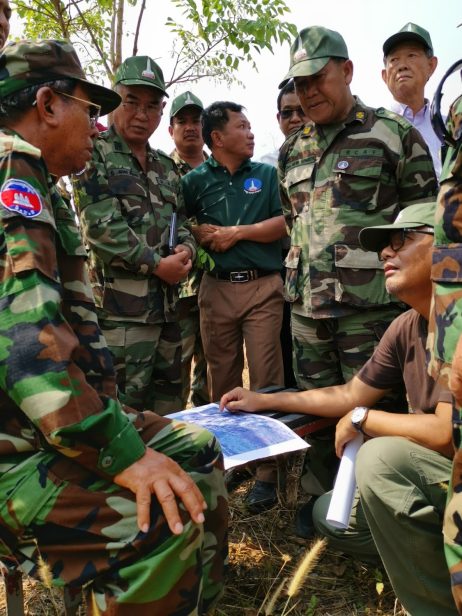As we commemorate the 30th anniversary of the Paris Peace Agreements, we would do well to recognize the importance of history, and in particular Cambodia’s military history, for the region and the world. Cambodia’s history should be recognized as a national resource to inform the country’s strategic development, influence, and leadership in the ASEAN region.
Military history has been described as the research of war and the analysis of victory and defeat; however, it also encompasses much more. Military history covers a range of topics from the rise and fall of regimes to the transformation of countries, and how humanity repeats and/or learns from its mistakes. Cambodia’s history is filled with unique lessons for the country, region, and world.
Cambodia was a significant crossroads in the Cold War struggle between ideologies, political systems, and foreign policy agendas. The history of Cambodia that led up to, and comprises part of, the history of foreign interventions in the region demonstrates how critical the country is to regional security, and the region’s security is to global security. Further, the mass atrocities, war, and deprivation that colored so much of Cambodia’s history in the latter part of the 20th century provide important lessons on the conditions that precipitate and result from instability, war, and genocide. Cambodia’s history is an illustration of the human spirit as much as a lesson in the depths of human depravity.
The history of Cambodia is also punctuated by numerous attempts by neighboring countries to encroach upon, occupy, and even usurp territory from the Cambodian people. Studying the history of these past relations, disputes, and conflicts will not provide a roadmap for current or future diplomatic or military affairs; however, this history is a national resource that empowers leaders with strategic wisdom on how to manage relations with neighbors and the world.
Cambodia’s history, and particularly its military history, provides an important resource for the development of strategic wisdom for the country, the region, and world leaders. Cambodia’s military history is full of lessons on how (and when) to wisely exercise restraint, when to exercise patience, and when to exercise boldness in defending national security. Cambodian military leaders can look to Cambodia’s military history as a national resource in building up not only their own strategic wisdom, but also the professionalism of their organization and officer ranks.

Samdech Pichey Sena Tea Banh, deputy prime minister and minister of national defense of Cambodia (sitting left), and his special advisor, General Nem Sowat (standing right), Lieutenant General Meas Sina (standing left), and Youk Chhang (sitting). The party was visiting a proposed military history zone near the Anlong Veng Peace Center, Oddar Meanchey Province, along the Cambodian-Thai border. Photo by Ly Kok-Chhay, March 6, 2020.
Cambodia’s national security depends upon a professional military organization. Professional military organizations require competent leaders who are not only strategists but also historians – because no successful strategy can be developed without an understanding of history.
History shapes the core components of all successful strategies. Military history ensures that strategy is not only informed by the current operational environment, tactics, and doctrine, but also the successes and mistakes of the past. History can provide insights into whether the objectives of a strategy are acceptable, whether the methods for achieving those objectives are even feasible, and how predecessors fared in using the same or different strategies in the past. Military history is a key component of all combined military and national security strategies.
The member states and collective leadership of the Association of Southeast Asian Nations (ASEAN) also require leaders that are historians as well as strategists. Cambodia’s military history is uniquely important to the peace and security of the region because many battles, struggles, and geopolitical strategies were centered within Cambodia’s military history.
Cambodia was a key center of gravity during the various wars, conflicts, and struggles that troubled the region in the 20th century. In the wake of the First Indochina War, Cambodia became independent, and during the Second Indochina War, Cambodia was the epicenter of one of the largest aerial bombardments in world history. Cambodia’s geopolitical location during the Second Indochina War made it a critical battleground between various competing actors.
During 1975-1979, the people of Cambodia also suffered unspeakable tragedy under the genocidal Khmer Rouge regime, and though the Khmer Rouge were overthrown from power in 1979, Cambodia continued to struggle with war, famine, and humanitarian crises resulting in the death, displacement, or resettlement of millions of Cambodians. The defeat of the Khmer Rouge was not only a strategic victory for Cambodia; it was a strategic victory for ASEAN and the world.
The military engagements, maneuvers, and strategies that played out in Cambodia between 1979 and 1993 rippled across the region, and to some extent many of these forces shaped (and still shape) the geopolitics of ASEAN today. Cambodia’s military history is a history of not only battles and military maneuvers but also key political decisions and strategies that remain important references for informing national security and collective ASEAN strategy in the Southeast Asian region today.
As we mark the 30th anniversary of the Paris Peace Agreements, we should take the opportunity to not only reflect on what we must learn from the history surrounding these agreements, but also how much we can learn from all of Cambodia’s history. The importance of this history has perhaps never been greater than now, as Cambodia prepares to assume the chair position for ASEAN in 2022.
As Cambodia prepares for its stint as ASEAN’s rotating chair, we should recognize this upcoming leadership role as an opportunity to leverage, among many other resources, Cambodia’s history to inform the Cambodian and ASEAN peoples’ collective development, partnership, and leadership. Cambodia’s history is part and parcel to envisioning a collective peace and security for the ASEAN region.

































